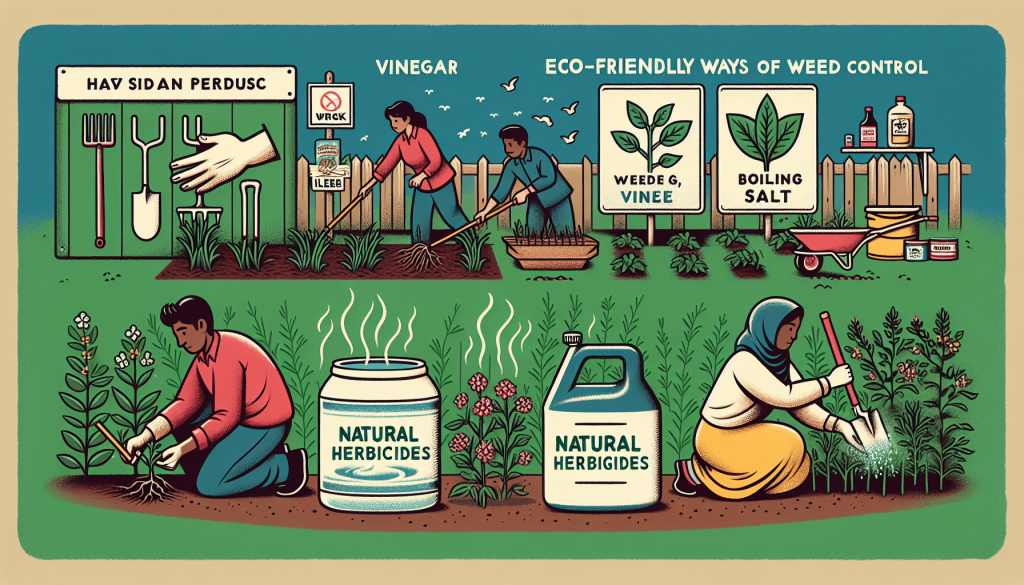This post may contain affiliate links. As an Amazon Associate, we may earn commissions from qualifying purchases.
Are you tired of stubborn weeds invading your garden and taking over your precious plants? If so, you’ll be glad to know that there are natural methods available for weed control that can help you reclaim your garden’s beauty without resorting to harmful chemicals. In this article, we will explore some effective and eco-friendly ways to combat weeds and keep your garden flourishing. From smothering weeds with organic mulch to using vinegar and boiling water as natural herbicides, you’ll discover a range of safe and sustainable methods that will leave your garden weed-free and thriving.
Mulching
Mulching is an effective and natural way to control weeds in your garden. By covering the soil around your plants with a layer of mulch, you can prevent weed growth and improve the overall health of your garden. There are several types of mulch to choose from, including organic options like wood chips, straw, and shredded leaves, as well as inorganic mulch like gravel or plastic.
Types of mulch
When it comes to selecting mulch for your garden, there are various options to consider. Organic mulches, such as wood chips and shredded leaves, are popular choices because they naturally break down over time and add valuable nutrients to the soil. They also help retain moisture, regulate soil temperature, and suppress weed growth. Inorganic mulches, like gravel or plastic, are effective at preventing weeds from germinating by blocking out sunlight.
How mulching prevents weed growth
Mulching creates a physical barrier between the soil and the sunlight, making it difficult for weed seeds to sprout and grow. When properly applied, a thick layer of mulch suppresses weed growth by blocking sunlight and reducing weed seed germination. Additionally, mulch helps to retain moisture in the soil, which can deter weed growth as many weed species thrive in dry conditions.
Applying mulch effectively
To effectively use mulch for weed control, it’s important to follow some key guidelines. Start by clearing the area of existing weeds and applying a layer of weed barrier fabric or cardboard to further suppress weed growth. Next, spread a layer of mulch around your plants, ensuring a thickness of 2-3 inches. Be careful not to pile mulch against plant stems, as this can cause rot or provide a hiding place for pests. Regularly check and replenish mulch as needed to maintain its weed-suppressing benefits.
Hand Pulling
For those who prefer a hands-on approach to weed control, hand pulling is a simple and effective method. By identifying and removing weeds manually, you can eliminate them before they have a chance to spread and compete with your desirable plants. However, it’s important to know how to properly identify weeds and use the right tools and techniques.
Identifying weeds
Accurately identifying weeds is crucial to effective hand pulling. Weeds can vary in appearance, so it’s important to familiarize yourself with common weed species in your area. Look for distinguishing characteristics like leaf shape, flower color, and growth habit. Online resources, gardening books, or local extension offices can provide valuable information and images to help you identify weeds accurately.
Tools needed for hand pulling
To successfully hand pull weeds, you’ll need a few essential tools. A hand trowel or a handheld weeder with a narrow blade is ideal for digging out weeds with taproots or deep roots. For larger weeds or those with extensive root systems, a long-handled dandelion digger or a weed wrench can provide extra leverage. Gloves are also essential to protect your hands from prickly or thorny weeds.
Proper technique for removing weeds
When hand pulling weeds, it’s important to remove the entire plant, including the roots, to prevent regrowth. Start by loosening the soil around the base of the weed using a trowel or weeding tool. Grasp the weed near the base and gently pull upward, ensuring that you extract the entire root system. Be cautious not to damage nearby desirable plants while removing weeds. Dispose of the pulled weeds away from your garden to prevent reseeding.

Vinegar
Vinegar is a commonly used natural herbicide that can be an effective tool for weed control. This household staple has high acidity, which can kill unwanted plants. However, it’s important to use vinegar correctly to avoid damaging desirable plants and to select the right type of vinegar for the job.
Using vinegar as a natural herbicide
Vinegar is effective at killing weeds by dehydrating their leaves and disrupting their cell membranes. The acetic acid in vinegar is responsible for its herbicidal properties. It’s important to note that vinegar is a non-selective herbicide, meaning it will harm any plants it comes into contact with. Therefore, it’s best to use vinegar on weeds growing in areas free from desirable plants, such as driveways, sidewalks, or between pavers.
Selecting the right type of vinegar
When using vinegar as a herbicide, it’s important to choose the right type of vinegar for maximum effectiveness. Distilled white vinegar with a concentration of 5% acetic acid is commonly used for weed control. This strength is readily available in most grocery stores. Avoid using vinegar with higher concentrations of acetic acid as they can be more harmful to the environment and may require special handling precautions.
Application methods for weed control
There are a few different application methods when using vinegar as a herbicide. For small or young weeds, pouring undiluted vinegar directly onto the foliage can be effective. Take care to avoid spraying vinegar on desirable plants, as it can cause damage. For larger or more established weeds, repeated applications may be necessary. Remember to avoid applying vinegar on windy days to prevent drift onto desirable plants, and always follow safety instructions and guidelines provided on the vinegar packaging.
Boiling Water
Using boiling water to control weeds is an eco-friendly and inexpensive method that can be easily implemented in your garden. By pouring boiling water directly onto weeds, you can cause damage to their cell structure and kill them effectively. However, it’s important to exercise caution and follow safe application guidelines to avoid injury or damage to desirable plants.
The boiling water method
The boiling water method is a simple yet effective way to control weeds. Boil a pot or kettle of water until it reaches a rolling boil. Carefully and slowly pour the boiling water directly onto the weeds, making sure to saturate the leaves and the surrounding soil. The high temperature of the water will damage the weed’s cell structure, causing it to wither and die.
Safe application guidelines
When using boiling water for weed control, safety should be a priority. Always wear protective clothing, including long sleeves, pants, and gloves, to prevent burns or scalds. Use caution when handling boiling water and pour it slowly and carefully to avoid splashback. Be mindful of the surroundings and avoid pouring boiling water onto desirable plants or near sensitive areas, such as ponds or beehives.
Effectiveness of boiling water on weeds
Boiling water is highly effective at killing weeds, especially in areas where you want to avoid using herbicides or digging up the soil. It is most effective on annual weeds with shallow root systems. Perennial weeds or those with deep taproots may require repeated applications to ensure complete eradication. Boiling water is best used in small-scale weed control or to target specific areas rather than large sections of the garden.

Corn Gluten Meal
Corn gluten meal is a natural byproduct of the corn milling process and has gained popularity as an organic weed suppressant. It works by inhibiting the germination of weed seeds, reducing weed growth, and promoting a healthier lawn or garden. However, understanding its application timing and potential drawbacks is essential for achieving the best results.
How corn gluten meal works as a weed suppressant
Corn gluten meal acts as a pre-emergent herbicide, inhibiting the germination of weed seeds. When applied to the soil, it releases organic compounds that create a barrier, preventing weed seeds from developing into mature plants. It is important to note that corn gluten meal is effective against annual weeds, but it has limited effectiveness on perennial or established weeds.
Application timing for best results
Timing is crucial when using corn gluten meal as a weed suppressant. It should be applied before weed seeds germinate to maximize its efficacy. For spring and summer annual weeds, apply corn gluten meal in early spring, before the weed seeds sprout. For fall and winter annual weeds, apply in late summer or early fall. It’s important to follow the specific product instructions for the best application timing based on your region and target weed species.
Potential drawbacks and considerations
While corn gluten meal can be an effective natural weed suppressant, there are some considerations and potential drawbacks to keep in mind. As a pre-emergent herbicide, it primarily targets weed seeds and does not control established weeds. It is also important to avoid using corn gluten meal in areas where you plan to sow seeds of desired plants, as it can inhibit their germination as well. Additionally, corn gluten meal can be a food source for certain animals, so it’s important to prevent ingestion by pets or wildlife.
Natural Herbicides
When natural methods like hand pulling or mulching aren’t enough, natural herbicides can provide an additional tool for weed control. Homemade herbicidal solutions, as well as commercially available organic herbicides, can be used to supplement your weed control efforts. However, it’s important to understand their effectiveness and limitations.
Homemade herbicidal solutions
Homemade herbicidal solutions are cost-effective and can be made using common household ingredients. Vinegar, salt, and dish soap are common components of homemade herbicides. The acetic acid in vinegar acts as a herbicide, while salt dehydrates plant cells. Dish soap helps the solution adhere to plant surfaces. When using homemade herbicides, it’s important to follow recipes carefully and exercise caution to avoid damage to desirable plants.
Commercially available organic herbicides
For those who prefer a ready-to-use option, there are commercially available organic herbicides on the market. These products are formulated with plant-derived ingredients or natural substances and can be effective at killing weeds. Some examples include herbicidal soaps, citrus oil-based sprays, or essential oil-based herbicides. It’s important to carefully read and follow the instructions provided by the manufacturer to ensure safe and effective use.
Effectiveness and limitations
While natural herbicides can be effective at killing weeds, they may not offer the same level of efficacy as synthetic herbicides. Weed species, stage of growth, and environmental conditions can influence the effectiveness of natural herbicides. It’s important to remember that natural herbicides are non-selective, meaning they can harm or kill desirable plants as well. Regular monitoring and spot treatment may be necessary for optimal weed control.
Solarization
Solarization is a natural method of weed control that utilizes the sun’s heat to kill weeds, pathogens, and weed seeds in the soil. By covering an area with a clear plastic sheet and allowing the sun to heat up the soil, you can effectively reduce weed pressure and prepare the soil for planting. Understanding the solarization process, preparing the soil, and knowing the duration for success are essential for this technique.
Understanding the solarization process
Solarization harnesses the power of the sun to raise the temperature of the soil, effectively killing weeds, pathogens, and weed seeds. By covering the soil with a clear plastic sheet, solar energy is trapped, creating a greenhouse-like environment. As the temperature under the plastic increases, the soil heats up, and the weed seeds, as well as some pests and diseases, are killed. This process can take several weeks or even months, depending on the climate and the desired outcome.
Preparing the soil for solarization
To prepare the soil for solarization, start by removing any existing weeds or plant debris from the area. For best results, cultivate the soil lightly to break up clumps and create a smooth planting surface. Irrigate the area to moisten the soil, as moist soil conducts heat more effectively. Once the area is prepared, cover the soil with a clear plastic sheet, ensuring it is tightly secured at the edges to trap heat.
Duration and success rate
The length of time required for solarization depends on various factors, including the climate, soil type, and the weed species being targeted. In hot, sunny climates, solarization can be most effective during the summer months, typically requiring 4-6 weeks of continuous sunlight exposure. In cooler climates, solarization may take longer, necessitating longer durations for optimal results. Regularly monitor the soil temperature and adjust the duration as needed to achieve the desired level of weed control.
Flame Weeding
Flame weeding is a method of weed control that harnesses the power of flames to kill weeds. By exposing weeds to intense heat, their cell structure is damaged, leading to their demise. However, it’s important to follow safety precautions, use appropriate equipment, and choose suitable environments for flame weeding.
Using flames to control weeds
Flame weeding involves using a hand-held propane torch or a specialized flame weeder to direct intense heat onto weeds. The intense heat causes the water in the weed’s cells to vaporize, leading to cell death and ultimately killing the plant. Flame weeding can be an effective weed control method for large areas or areas with dense weed populations.
Safety precautions
Safety is of utmost importance when using flame weeding as a weed control method. Always wear protective clothing, including long sleeves, pants, gloves, and safety goggles, to protect yourself from potential burns or injuries. Keep a fire extinguisher or water source nearby in case of accidents. Avoid using flame weeding in dry, windy conditions or during fire bans to prevent accidental ignition of dry vegetation or surrounding structures.
Suitable environments for flame weeding
Flame weeding is most effective in areas with mostly annual weeds or with weed populations that have not yet produced seeds. It can be used in gardens, driveways, walkways, or other hard surfaces with a low risk of fire spread. Flame weeding is less suitable for areas with desirable plants, as it can damage or kill them. Regular monitoring and multiple treatments may be necessary to control weed regrowth effectively.
Cover Crops
Cover crops are an excellent natural method for weed control as they help suppress weed growth through competition, improve soil health, and add organic matter to your garden or field. By planting cover crops, you can create a living mulch that outcompetes weeds, preventing them from overtaking your desired plants.
Selecting appropriate cover crops
Choosing the right cover crops for weed control depends on your specific goals, climate, and soil conditions. Some cover crops with excellent weed-suppressing abilities include annual ryegrass, buckwheat, clover, and winter rye. These plants grow quickly, creating dense foliage that shades out weeds. It’s important to select cover crops that are well-suited to your growing region and that provide effective weed suppression.
Suppressing weed growth through competition
Cover crops work to suppress weed growth by outcompeting them for light, water, and nutrients. After planting cover crops, their rapid growth and dense foliage shade the soil, preventing weed seeds from germinating and establishing. This shading effect also inhibits weed seed growth by reducing sunlight availability. The root systems of cover crops also help break up compacted soil, improving soil structure and preventing weed growth.
Management practices for successful results
To effectively use cover crops for weed control, proper management practices are essential. It’s important to ensure good seed-to-soil contact when planting cover crops to encourage germination and establishment. Regular irrigation and weed management are critical during the cover crop’s growth period to prevent weed competition. To maximize the weed-suppressing benefits, terminate the cover crop before it flowers and produces seeds, preventing reseeding and potential weed issues.
Companion Planting
Companion planting is a natural and holistic approach to weed control that involves strategically planting beneficial plant combinations to deter weeds and promote the health and productivity of your garden. By choosing companion plants that work synergistically, you can create a natural barrier against unwanted weeds.
Beneficial plant combinations for weed control
Certain plant combinations have been found to effectively suppress weed growth and deter unwanted pests. For example, planting tall-growing plants like tomatoes or corn can create a shade canopy that limits weed growth by reducing sunlight availability. Similarly, planting low-growing groundcovers such as creeping thyme or clover can act as living mulch, smothering weeds and suppressing their growth.
Companion plants that deter specific weeds
Some companion plants have been shown to have specific weed-deterrent properties. For instance, planting marigolds can repel nematodes, a type of soil-dwelling pest, while also suppressing weed growth. Nasturtiums are known to deter aphids, whiteflies, and other common garden pests while attracting beneficial insects. Researching and selecting companion plants that have specific weed or pest repelling properties can greatly enhance your weed control efforts.
Designing an effective companion planting scheme
To create an effective companion planting scheme for weed control, consider the growth habits, root systems, and nutrient requirements of the plants you wish to combine. Choose companion plants that have complementary characteristics and avoid combining plants that compete for the same resources or space. Proper spacing, regular maintenance, and monitoring are key to ensure the desired benefits of companion planting. Regularly remove any weeds that manage to establish themselves among companion plants to prevent competition.
In conclusion, natural methods for weed control offer environmentally friendly alternatives to synthetic herbicides and mechanical removal. From mulching and hand pulling to using vinegar, boiling water, corn gluten meal, and natural herbicides, there are various effective approaches to suit every gardener’s preferences. Additionally, techniques like solarization, flame weeding, cover cropping, and companion planting provide additional tools in the natural weed control arsenal. By employing these methods, you can maintain a weed-free garden while minimizing harm to the environment and promoting the health and vitality of your plants.








